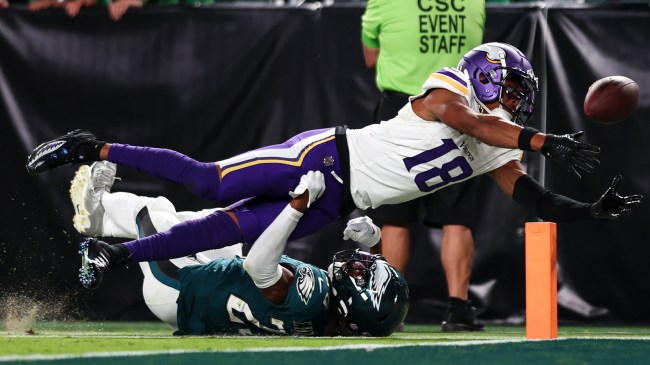
Getty Image
It looked like the Week 2 showdown between the Eagles and the Vikings was going to become the latest in a long line of frustrating football games NFL fans have been subjected to since Amazon bought the rights to Thursday Night Football thanks in no small part to the turnovers that plagued the first half—none of which were more consequential than a play involving Justin Jefferson.
With less than a minute to go in the second quarter, Minnesota was trailing 10-7 when Kirk Cousins connected with Jefferson on a deep pass that appeared to put Minnesota on the goal line.
The wide receiver fumbled the ball while going to the ground, and while it was initially spotted just short of the pylon, the officials took a second look at the play in question and determined it had actually gone out of the end zone, which meant the Eagles got possession on their own 20-yard line as the result of a touchback.
Full play here, worst rule in football, easily.#Vikings turn it over. pic.twitter.com/o0V8COb9ojhttps://t.co/Lu5rvMHbV3
— Dov Kleiman (@NFL_DovKleiman) September 15, 2023
That turned out to be an incredibly pivotal ruling, as Minnesota not only missed out on the chance to score a touchdown but gave Philadelphia the opportunity to drive down the field before Jake Elliott booted a 61-yard field goal in the closing seconds of the half for what essentially amounted to a 10-point swing.
That was just the most recent incident where the controversial touchback rule reared its ugly head, and there’s no better excuse to take a look at the outdated reason it exists in the first place.
Why the NFL considers a fumble out of the end zone a touchback
The bulk of what we’re about to discuss comes courtesy of NFL reporter Mike Tanier, who previously took the time to explore the origins of the touchback rule after it repeatedly reared its ugly head in 2017.
As Tanier notes, you can trace the current controversy all the way back to 1906, which is when Walter Camp (the man known as “The Father of American Football”) put together a rulebook to bring some order to a game that was still in its relative infancy.
Camp defined a touchback as any play where the football ended up in (or out of) the offensive team’s end zone on plays where “the impetus which sent it to or across the line was given by an opponent.” That not only applied to kicks, interceptions, and (yes) fumbles but also incomplete passes, which hinged on the logic that the quarterback was responsible for throwing the ball into the end zone in the first place.
That rule remained in place for more than 25 years until the NFL (which was formed in 1920) updated its rules to remove incomplete passes from the list of plays eligible for a touchback in 1933. However, the league decided to keep the fumble on the books.
For decades, the rule wasn’t really enforced; prior to the advent of replays and challenges, officials tended to err on the side of entertainment while allowing the team that technically turned the ball over to retain possession on the goal line in the wake of fumbles like the one Jefferson committed.
However, the tides slowly but surely began to turn as more and more teams (understandably) cited the rule to ensure they were given the competitive advantage it grants them.
While most fans, players, and coaches won’t complain when it benefits their team, it’s still a bit hard to understand exactly why the NFL hasn’t taken a closer look at this; simply spotting the ball at the spot of the fumble instead of giving possession to the other team seems like a change most people would embrace (Peter King has also suggested a half-measure that would involve giving the team that benefits the ball back at the spot of the fumble has opposed to the 20-yard line).
At this point, it doesn’t seem like the NFL has a ton of motivation to change a rule that has caused plenty of headaches over the years, but it might finally be time to do exactly that.